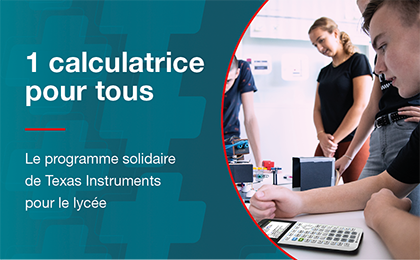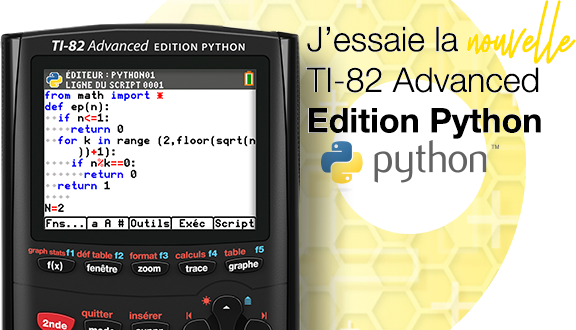
Aux Etats-Unis d'Amérique, le
SAT (Scholastic Assessment Test) est l'un des principaux examens de fin d'enseignement secondaire. Cet examen est géré par le
College Board, une organisation privée à but non lucratif. Il fait partie des examens pouvant être exigés pour une inscription dans une université ou autre établissement d'enseignement supérieur.
4 sessions de l'examen sont organisées dans l'année scolaire, usuellement début novembre, début décembre, début mars et début mai.
Au
SAT, l'épreuve de Mathématiques autorise entre autres la calculatrice graphique, mais cette dernière doit faire partie d'une liste de modèles approuvés.
Contrairement à d'autres listes
(Pays-Bas, Portugal, ...), celle du
SAT jusqu'à présent n'a jusqu'à présent jamais retiré les anciens modèles.
Les modèles approuvés étaient en 2023-2024 :
- Casio :
- séries fx-6000/6200/6300/6500
- séries fx-7000/7500 et fx-8000/8500
- séries fx-7700/7800 et fx-8700/8800
- séries fx-7300/7400
- séries fx-9700/9750
- série fx-9860
- séries cfx-9800/9850/9950/9970
- séries FX 1.0 et Algebra FX 2.0
- séries fx-CG20
- fx-CG10/50
- fx-CG500 (sans le stylet tactile)
- séries Graph 25/35/75/95/100
- Hewlett Packard :
- HP 9G
- HP 38G
- séries HP 28/39/40/48/49/50
- HP Prime
- Sharp :
- EL-5200
- séries EL-9200/9300
- série EL-9600 (sans le stylet tactile)
- série EL-9900
- Texas Instruments :
- TI-73
- TI-80/81/82/83/85/86/89
- TI-83 Plus, TI-83 Plus Silver Edition
- TI-84 Plus, TI-84 Plus Silver Edition
- TI-84 Plus T
- TI-84 Plus C Silver Edition
- TI-84 Plus CE, TI-84 Plus CE-T
- TI-84 Plus CE Python, TI-84 Plus CE-T Python Edition
- TI-89 Titanium
- TI-Nspire
- TI-Nspire CX, TI-Nspire CM-C
- TI-Nspire CX II
- TI-Nspire CX II-T
- TI-Nspire CAS
- TI-Nspire CX CAS, TI-Nspire CX-C CAS, TI-Nspire CM-C CAS
- TI-Nspire CX II CAS, TI-Nspire CX II-T CAS, TI-Nspire CX II-C CAS
- RadioShack (clones d'anciennes Casio) :
- Autres :
- Datexx DS-883 (=Citizen SRP-400G, dérivées de la calculatrice en marque blanche Kinpo SG2)
- Micronta
- Smart² (=fx7700GB)
- NumWorks

Nous t'
annoncions pour l'année
2023-2024 de gros changements niveau calculatrices au
SAT.
Après une expérimentation l'année précédente, le
SAT se transformait et devenait le
Digital SAT.
La différence est que les candidats ne composent plus sur feuille de papier mais sur un ordinateur avec un logiciel dédié, la
Bluebook.
Niveau calculatrices, les candidats conservaient le choix :
- soit apporter leur calculatrice graphique conformément à la liste précédente
- soit utiliser une calculatrice graphique virtuelle directement intégrée au logiciel Bluebook

Pour l'intégration à
Bluebook, le
College Board avait choisi la calculatrice virtuelle
Desmos. Le logiciel
BlueBook n'étant pas utilisable sans identifiants, précisons que la calculatrice
Desmos dans sa version
Digital SAT est disponible
en ligne et que tu peux librement aller la tester.
Il nous semblait que les petits américains optant pour l'examen terminal
SAT avaient déjà fait dans une proportion très significative dès cette première année
2023-2024, le choix de ne plus s'équiper d'une calculatrice graphique physique, s'en remettant totalement à la calculatrice
Desmos virtuelle incluse.
Bernard Parisse, enseignant-chercheur à l'Université de Grenoble, nous avait partagé ses précieuses estimations de volume de ventes pour l'Amérique du Nord, réalisées à partir du nombre d'avis d'acheteurs sur
Amazon.com.
Si une estimation absolue peut toujours être contestée, il ne va pas de même de de la variation par rapport à l'année précédente :
- pour les TI-84 Plus CE, dans les -40% d'avis clients entre les rentrées 2022 et 2023
- pour la TI-84 Plus, dans les -27% d'avis clients entre les rentrées 2022 et 2023
Le
SAT n'étant qu'un seul des examens de fin d'enseignement secondaire proposés en Amérique du Nord, un effondrement aussi significatif du volume globale ne pouvait signifier qu'une chose : dès cette année
2023-2024, une majorité de candidats au
SAT n'avaient plus acheté de calculatrice graphique physique et s'en étaient remis entièrement à
Desmos.
Aujourd'hui nous avons du nouveau à ce sujet.
Nous sommes en possession d'un projet de nouvelles règles prévu pour s'appliquer au
SAT année
2025-2026, brièvement publié sur la
page officielle listant les calculatrices autorisées
(21 avril 2025) avant d'être retiré dès le lendemain
(22 avril 2025).
Même si les nouvelles règles ont vite été retirées
(pour le moment), elles n'en restent pas moins fort éclairantes sur la tendance évoquée précédemment ainsi que sur ce qui se joue en interne.

Ephémère bandeau en haut de page, donc :
College Board wrote:[b]Important: For fall 2025, College Board will update its calculator guidance to better identify calculators that can't be used on the SAT Suite of Assessments. Students may still plan to bring a handheld calculator for testing, but if that calculator model is on the prohibited list, students must use the
Desmos calculator included in Bluebook instead.
Il s'agissait donc d'une annonce d'une refonte de la page en question pour l'automne 2025
(et donc la session 2026), pour non plus fournir une liste de modèles autorisés, mais inversement détailler les critères d'interdiction.

Et pour y voir plus clair, nous avions même une section FAQ rajoutée en bas de page :
College Board wrote:Where can I find a list of permitted graphing calculators?
We no longer maintain a list of graphing calculators that are specifically permitted for use on the SAT Suite. Refer to the list of prohibited calculators on this page (coming soon) for devices students may not use on the SAT Suite.
Are there calculators that have been previously permitted but are no longer allowed for the SAT Suite?
Yes. Refer to the list of prohibited calculators on this page (coming soon) for details.
Are the new calculator guidelines a change in policy?
No, this is a clarification of existing policy. Due to changes in the market for calculators and the growing availability of computer algebra system (CAS) technology, the description of certain prohibited features (e.g., QWERTY-style keyboards) has become inadequate for fully capturing our guidelines for acceptable calculators.
Is the list of prohibited calculators for the SAT Suite the same for AP exams?
Not necessarily. The AP program maintains its own calculator policy.
Why are calculators with CAS functionality allowed on AP exams but not allowed on the SAT Suite?
Calculators with computer algebra system (CAS) functionality can affect accurate assessment of the math abilities that the SAT Suite is designed to test. CAS functionality doesn't present the same problem for AP exams.
Does Bluebook give students alternatives to a physical calculator?
Yes. Bluebook provides all students with a built-in Desmos calculator. In a survey following the March 2025 SAT Weekend administration, 85% of students reported using the Desmos calculator and finding it easy to use. Starting in fall 2025, students can use either a scientific calculator version or graphing calculator version, depending on their preference.
How often do calculator guidelines for the SAT Suite change?
Calculator guidelines for the SAT Suite may change as frequently as once a year. Such changes will be finalized and communicated in time for the August SAT Weekend administration and for fall in-school testing.
Voilà qui est intéressant.
Peu d'intérêt à le faire, mais la migration d'une liste de modèles approuvés à une liste de critères d'interdiction a donc une conséquence : les candidats au
SAT année
2025-2026 pourraient utiliser une simple calculatrice scientifique à la place de la calculatrice graphique.
Alors qu'elles sont actuellement clairement autorisées d'après la liste, les calculatrices avec fonctionnalité
CAS deviendraient interdites au nouvel
SAT 2025-2026.
Et surtout la section nous valide la tendance massive précédemment supposée : au
SAT session
mars 2025, ce sont
85% des candidats qui se sont contentés de la calculatrice graphique virtuelle
Desmos intégrée au logiciel d'examen
Bluebook, et l'aurait en prime trouvée simple à utiliser.
Par soustraction, il y aurait désormais moins de 15% des petits américains passant le
SAT qui achètent et apportent une calculatrice graphique aux épreuves. En seulement 2 ans et alors qu'il n'y avait aucune interdiction
(juste une incitation), nous ne pouvons qu'être effrayés par la part désormais massive de candidats au
SAT ayant choisi de faire l'économie d'une calculatrice graphique.


Précisons que les mêmes règles pour les calculatrices s'appliquaient également jusqu'ici aux examens voisins du
College Board, les
PSAT/NMSQT, et que les nouvelles règle ont également fait une brève apparition à la même date sur la
page officielle dédiée.

 Picross nous est ici adapté pour calculatrices TI-Nspire CX II par Ilyas R., qui a suivi l'enseignement de spécialité NSI en Première auprès de Vincent Robert alias cent20 au Lycée Louis Pasteur en Avignon.
Picross nous est ici adapté pour calculatrices TI-Nspire CX II par Ilyas R., qui a suivi l'enseignement de spécialité NSI en Première auprès de Vincent Robert alias cent20 au Lycée Louis Pasteur en Avignon.
























